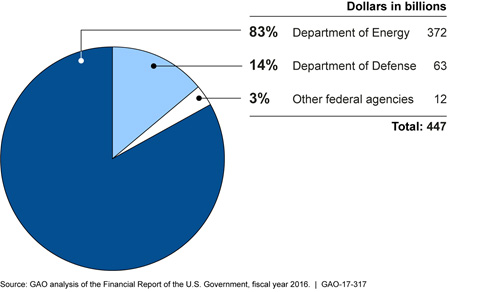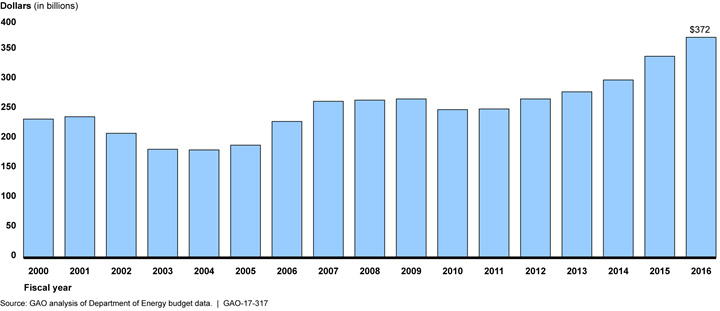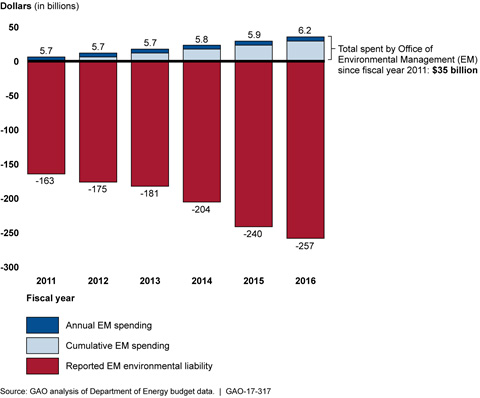
Workers clean 5,700 feet of piping on Alpha 4’s west side at the Y-12 National Security Complex in Oak Ridge. Alpha 4 was built in 1944. It was used first for enriching uranium as part of the Manhattan Project and later for thermonuclear weapons production. It was shut down in 1987 and will be demolished. (Photo by U.S. Department of Energy)
Note: This story was last updated at 3:20 p.m. September 4.
The U.S. Department of Energy is responsible for more than 80 percent of the U.S. government’s estimated $450 billion in environmental liabilities, a federal agency said in a report published this year.
The agency, the U.S. Government Accountability Office, added the government’s environmental liabilities to a high-risk list of federal programs and operations in a report published in February.
Total environmental liabilities for the federal government are estimated at $447 billion. DOE is responsible for about $372 billion of them, or 83 percent, according to a fiscal year 2016 estimate, the GAO said.
Most of DOE’s environmental liability is related to nuclear waste cleanup, the GAO said. Fifty percent of it is at two cleanup sites: the Hanford Site in Washington state and the Savannah River Site in South Carolina.
The GAO—an independent, nonpartisan agency that works for Congress—said DOE’s total reported environmental liability has generally increased since 2000. It’s roughly doubled from a low of $176 billion in fiscal year 1997 to the higher estimate of $372 billion in fiscal year 2016.
“In the last six years alone, EM (environmental management) has spent $35 billion, primarily to treat and dispose of nuclear and hazardous waste and construct capital projects to treat the waste, while EM’s portion of the environmental liability has grown over this same time period by over $90 billion, from $163 billion to $257 billion,†the GAO said.
In the past few fiscal years, DOE environmental management has spent about $6 billion per year. The budget request submitted to Congress by President Donald Trump in May asked for $6.5 billion for the DOE Office of Environmental Management, the largest request in a decade.
Oak Ridge has a DOE environmental management program. It received more than $400 million in funding per fiscal year between 2013 and 2016. The Oak Ridge Office of Environmental Management has major cleanup projects at the East Tennessee Technology Park (the former K-25 site), Oak Ridge National Laboratory, and Y-12 National Security Complex. Cleanup work depends upon funding, but it could continue into the mid-2040s. Although they might be in various stages, projects that are under way now include finishing demolition work at ETTP by 2020, disposing of uranium-233 at ORNL, addressing high-risk excess facilities at ORNL and Y-12, building a Mercury Treatment Facility at Y-12, and shipping transuranic waste to the Waste Isolation Pilot Plant in New Mexico.
Oak Ridge was built as part of the top-secret Manhattan Project during World War II. While some old, dilapidated buildings are being demolished and ETTP is being cleaned up, nuclear weapons work, among other activities, continues at Y-12 and scientific research continues at ORNL.
In February, the GAO said it had added federal environmental liabilities to its high-risk list in a study that it does every two years. Since 1994, the GAO said, it has made at least 28 recommendations related to federal environmental liabilities, but 13 have not been implemented.
The agency said DOE, the federal agency responsible for most of those environmental liabilities, attributed recent increases in them to inflation adjustments, revisions in technical approaches or the scope of cleanup activities, regulatory and legal changes, and improved and updated estimates, including changes resulting from deferred or accelerated work. Another cause for a liability increase: The lack of a disposal path for high-level radioactive waste because of the termination of the Yucca Mountain repository program in Nevada and delays and scope changes for major construction projects at Hanford and Savannah River.
The GAO said there are several possible causes for the large and growing amount of money that DOE will need to meet its cleanup responsibilities.
“First, as our and other organizations’ reports issued over the last two decades have found, DOE’s environmental cleanup decisions are not risk-based, and its risk-based decision making is sometimes impeded by selection of cleanup remedies that are not appropriately tailored to the risks presented, and inconsistencies in the regulatory approaches followed at different sites,†the GAO said. “We and others have pointed out that DOE needs to take a nation-wide, risk-based approach to cleaning up these sites, which could reduce costs while also reducing environmental risks more quickly.â€
Second, DOE’s cleanup approach is based primarily on a series of compliance agreements and consent orders between DOE, the Environmental Protection Agency, and state regulators, the GAO said.
“According to one DOE official, 40 such agreements establish the requirements for DOE’s cleanup work,†the GAO said. “We have reported in the past that these agreements include thousands of associated milestones. Some of the 40 agreements were made decades ago and may be based on outdated information about the effectiveness of certain cleanup technologies.â€
Finally, DOE may have insufficient controls in place to accurately account for its environmental liabilities, according to the GAO.
Progress in addressing the federal government’s environmental liabilities depends, among other things, on how effectively federal departments and agencies set priorities that maximize the risk reduction and cost-effectiveness of cleanup approaches—even as those organizations are under increasingly restrictive budgets.
“As a first step, some departments and agencies may need to improve the completeness of information about long-term cleanup responsibilities and their associated costs so that decision makers, including Congress, can consider the full scope of the federal government’s cleanup obligations,†the GAO said. “As a next step, certain departments, such as DOE, may need to change how they establish cleanup priorities. For example, DOE’s current practice of negotiating agreements with individual sites without considering other sites’ agreements or available resources may not ensure that limited resources will be allocated to reducing the greatest environmental risks and costs will be minimized.â€
The GAO recommended actions to federal agencies that it said would, if implemented, improve the completeness and reliability of the estimated costs of future cleanup responsibilities and lead to more risk-based management of the cleanup work.
The GAO said DOE’s Office of Environmental Management has spent more than $164 billion to retrieve, treat, and dispose of nuclear and hazardous waste since 1989. So far, EM has completed 91 of 107 sites across the country, and those sites were generally viewed by the department as the smallest and least contaminated sites to address, the GAO said.
The GAO said some costs can’t yet be estimated. For example, DOE has not yet developed a cleanup plan or cost estimate for the Nevada National Security Site, which is nearly 1,400 square miles and has been used for hundreds of nuclear weapons tests since 1951. (Some uranium-233 that is now stored in Oak Ridge is being shipped to the Nevada National Security Site.)

The East Tennessee Technology Park, also known as Heritage Center in west Oak Ridge, is pictured above in this aerial photo from 2015. Buildings are being demolished and the site cleaned up, and ETTP is being converted into a private industrial park. The large building that extends from left to right at left-center is the former K-27 Building, where demolition work was completed in August 2016. (Photo courtesy CROET)
The GAO said the federal government’s total estimated environmental liability of $447 billion in fiscal year 2016 is more than double the $212 billion estimate in fiscal year 1997.
At 14 percent, the U.S. Department of Defense had, after DOE, the second-largest share of the federal government’s reported environmental liability, or $63 billion in fiscal year 2016, the GAO said.
The rest of the federal government makes up the remaining 3 percent of the liabilities. That includes agencies such as the National Aeronautics and Space Administration (NASA), and the departments of agriculture, interior, transportation, and veterans affairs, which all have large liabilities, the GAO said.
“When federal government activities contaminate the environment, various federal laws, agreements with states, and court decisions put the government on the hook for the cleaning bill,†the GAO said. “The federal government’s environmental liability has been growing for the past 20 years and is likely to continue to increase as agencies continue to better understand the complexities of the cleanup mission.â€
The GAO said the federal government’s estimated environmental liability of $447 billion in fiscal year 2016 does not reflect all of the future cleanup responsibilities that federal agencies may face.
“Because of the lack of complete information and the often inconsistent approach to making cleanup decisions, federal agencies cannot always address their environmental liabilities in ways that maximize the reduction of health and safety risks to the public and the environment in a cost-effective manner,†the GAO said.
“The federal government is financially liable for cleaning up areas where federal activities have contaminated the environment,†the GAO said. “Various federal laws, agreements with states, and court decisions require the federal government to clean up environmental hazards at federal sites and facilities—such as nuclear weapons production facilities and military installations. Such sites are contaminated by many types of waste.â€
Some federal agencies do not take a holistic, risk-informed approach to environmental cleanup that aligns limited funds with the greatest risks to human health and the environment, the GAO said. Since 1994, the agency has made at least 28 recommendations related to addressing the federal government’s environmental liability, including 22 to the Department of Energy or the Department of Defense.
The GAO said federal agencies’ approaches to addressing their environmental liabilities and cleaning up the contamination from past activities are often influenced by numerous site-specific factors, stakeholder agreements, and legal provisions.
More information will be added as it becomes available.

Total Reported U.S. Environmental Liability, Fiscal Year 2016 (Image courtesy U.S. Government Accountability Office)

Total Reported Department of Energy Environmental Liability, Fiscal Years 2000 to 2016 (Image courtesy U.S. Government Accountability Office)

U.S. Department of Energy’s Office of Environmental Management’s Annual Spending and Growing Environmental Liability (Image courtesy U.S. Government Accountability Office)
See a GAO page on the U.S. government’s environmental liability here. It includes sections on “Why It’s High Risk,” “What We Found,†and “What Remains to be Done.â€
See information on the GAO High-Risk Series here.
See the High-Risk Series report from February 2017 here.
See a environmental liability high-risk issue summary page here.
Learn more about cleanup work on the Oak Ridge Reservation here.
Do you appreciate this story or our work in general? If so, please consider a monthly subscription to Oak Ridge Today. See our Subscribe page here. Thank you for reading Oak Ridge Today.
Copyright 2017 Oak Ridge Today. All rights reserved. This material may not be published, broadcast, rewritten, or redistributed.








Leave a Reply